Three days in Florence
Florence is one of those cities in Italy that you will fall deeply in love with. From its perfectly arranged narrow streets with Baroque styled buildings to its fine cuisine, it is for sure a destination that is worth a visit. I went to Florence for my birthday in January with my family and spend there three days exploring this magnificent city.
Florence or Firenze as it is mostly known is the capital of the region of Tuscany and was founded by the Romans around a century before the birth of Christ. The city was famous in the past for being the capital of Italy for some time around the twelfth century and even a republic that had its own economy and government separated from Italy’s. The city of Florence was so powerful during the Middle ages that it had its own language and a local coin named florin. Florence became even more famous around the fourteenth and sixteenth centuries when it excelled in its commerce, education and fine arts.
The city was one of the wealthiest and most developed cities during the Medieval Ages and the Renaissance. During the Middle ages, most of the well-known architects and artists were creating one of the finest pieces of art in Florence. Among them were Leonardo da Vinci, Michelangelo, Galileo, Machiavelli, and Dante.
Florence became even more prosperous with the arrival of the Medici family around the twelfth century. The Medici family was well-known for its banking and commerce, which made them one of the most famous and wealthiest families in Italy. While they were living and prospering in Florence, they helped to build and finance the establishment of many buildings that are still standing to this day. Most of the well-known Medici buildings are the Pitti Palace, which was the residence for the family for a long time, the Boboli gardens just behind their palace, the Belvedere fortification built to protect the palace of the family and the Palazzo Medici, which was the first residence of the family. In addition to that, all the artworks that were belonging to the Medici family can be observed in the Uffizi gallery, where all the paintings and statues are put on display. However, even though the Medici family was ruling for a couple of centuries, it disappeared after the death of the last Medici heir.
The easiest and most convenient way to get to Florence?
When I was travelling to Florence with my family, we first took a flight to the airport of Bologna. From Bologna, we bought tickets for the train to Florence with Trenitalia, which is the Italian railways and cost us 9.45 euros for each person for one way. Bear in mind, that sometimes you will have to change the trains at certain train stations and you can also get a discount depending on your age and train types. This can be checked at the official website of Trenitalia. However, when buying a ticket for the train to Florence, it is good to specify that you want to take off at Firenze S. M. Novella, which is exactly at the beginning of the old city of Florence. This way it will be easier to navigate around the city and it is not so far away from the landmarks.
Where and what to eat in Florence?
Honestly, Florence is that city in Italy that for me offers the best Italian cuisine ever. I know it might sound a bit exaggerated to you, but trust me, I have been in many parts of Italy and I found that the food in Florence is absolutely delicious.
Me and my family were constantly strolling around Florence, as we wanted to see, as much as possible for three days, so we were always eating out in restaurants. One of my favourite restaurants in the Borghetto Ristorante near Pitti Palace. There we found traditional Tuscan food options and they were quite delish. My favourite dish there was the Lampredotto Toscano, which is consisting of a veal stomach along with various vegetables like potatoes, peppers, and carrots. All of these are cooked together and served along with some soft bread. However, when we were on the run, we would always order the Panino lampredotto or the sandwich with lampbredotto, which was also very good.
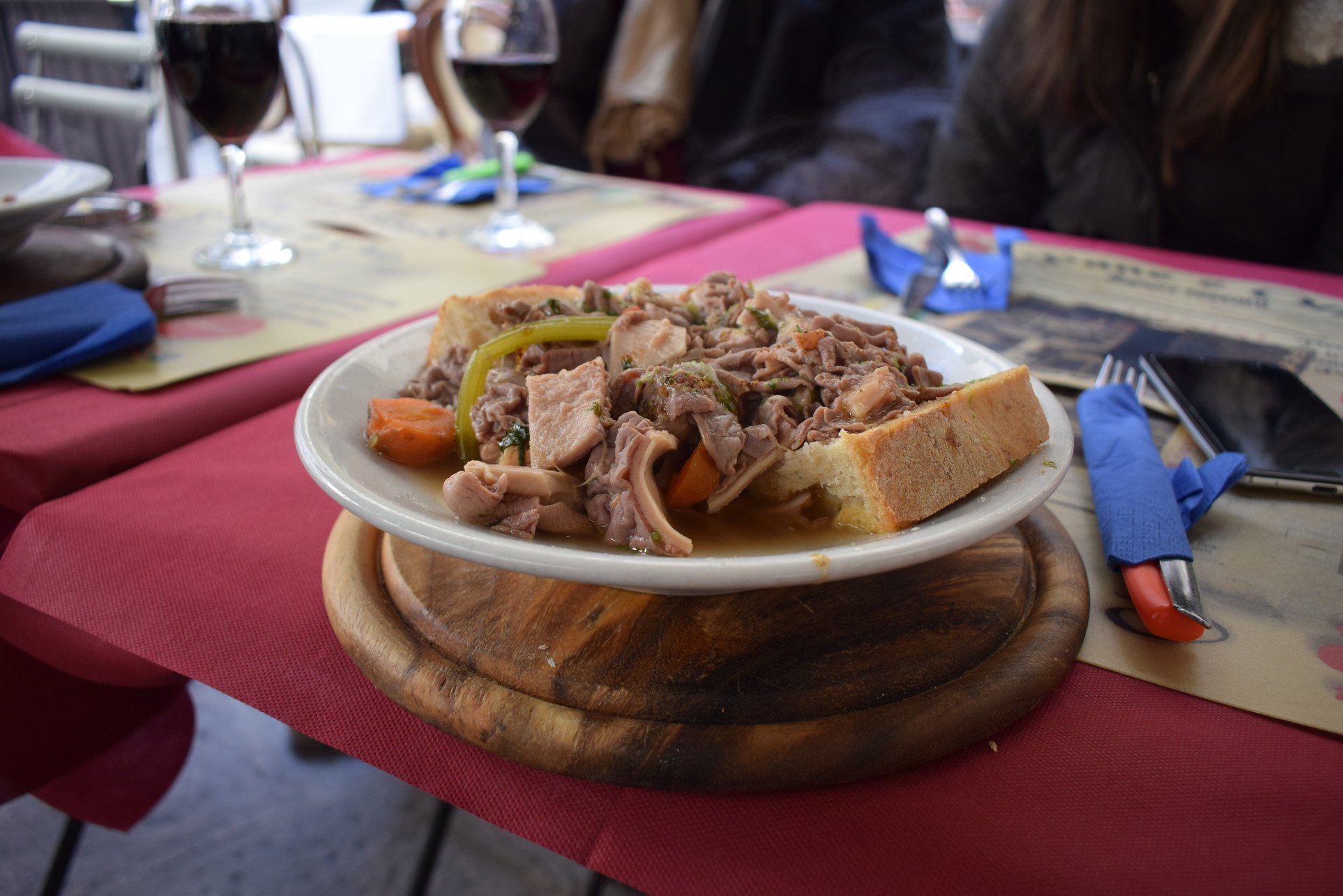
On the other side of the street, a bit closer to the shops is La Galleria Il Vino dei Guelfi, which was a small unpretentious restaurant that offered lots of options for pizza and pasta. There I would always have pasta with truffles and mushrooms, as it was quite incredible in taste. I have never eaten something so tasty. The restaurant is also not that expensive, and usually, you can eat a lot for ten euros.
While we were exploring the center of Florence we visited the Ristorante Pizzeria I'Daviddino, where we ordered some pizza and I got a hamburger, which was as well very tasty. The prices there are quite normal and you can have a decent lunch for around ten or fifteen euros.
Last but not least, try the gelato! Even if it is winter, do try it! It is the perfect dessert after any meal. However, be careful when picking your gelato and always check if it has ice pieces. If it has them, then check another one, as this one won’t be this good.
First day in Florence
My first day was spend strolling around Florence and one of its most prominent landmarks that were spread around the old Renaissance city.
Basilica di Santa Maria Novella
Right after we took off the train from Bologna we saw the Basilica di Santa Maria Novella. It was built the thirteenth century in the typical Gothic Florentine architectural style with lots of marble pieces in different colours. Inside of the basilica, there is a huge altar designed in the same style as the exterior and there is also the famous crucifix of Giotto, which shows the last breath of Jesus. The basilica also has very interesting corridors full of inscriptions on both sides and frescoed ceilings.
The price of the full ticket to enter the complex of the Basilica di Santa Maria Novella is 7.50 euros and can be purchased online.
The Complex of Basilica di San Lorenzo
After the Basilica di Santa Maria Novella we continued to the Basilica di San Lorenzo to explore its complex. The price to enter was nine euros and also included a visit to the Laurentian Medici Library, which is considered to hold the most important and prestigious collection of ancient books in Italy.
The Basilica di San Lorenzo is entirely decorated with white marble and is quite spacious. It was built around the fourth century and its exterior is not as lavish as that of the Cathedral of Florence, but its interior is quite beautiful. During the ages, it was renovated a couple of times and in the fifteenth century, the Medici family hired Filippo Brunelleschi to re-design the basilica to their liking. Once we entered it, we first saw the Cloister of the Basilica di San Lorenzo, which was like a nice little secluded garden inside the complex surrounded by buildings. On the walls of the cloister, there were lots of inscriptions and frescoes from ancient times and I could also see the dome of the basilica that resembled that of the Cathedral of Santa Maria del Fiore. Going further we saw the treasury and the cellar where was the marble sarcophagus and the pillar of Cosimo di Medici, which was his resting place and tomb of the artist Donatello.
Then, we continued to the prominent Laurentian Medici Library, which was designed by Michelangelo. When we entered the library there was a long corridor with many seats on both sides of it that were serving as a place for people to sit and study and also for storing manuscripts. To me, the library of the Medici was the most interesting part of the complex and it was simply amazing!
In addition to the basilica, there were two chapels that were built around the sixteenth and seventeenth centuries to honour the Medici family, that’s why people called them the Medici Chapels. The New Sacristy chapel was designed by Michelangelo and was built with the sole purpose to be a mausoleum of the Medici family. The other chapel was the Chapel of the Princess, which is one of the most beautiful chapels I have even seen. It was decorated with marble in many different colours and was rich in altars, frescoes, and statues. Absolutely marvellous and definitely a must-see!
Porcellino
The Porcellino of Florence is no ordinary landmark, but it is the bronze fountain of a boar. The bronze fountain of Porcellino was created at the beginning of the sixteenth century by the famous Italian sculptor Tacca. The statue of the boar is quite fascinating and it almost seems alive when you look at it. Many visitors in Florence go to the Porcellino, as it is considered to be good luck if you put a coin in its mouth and rub it on the back.
Piazza della Signoria
Going a bit to the left we found the Piazza della Signoria, which is one of the most famous and beautiful squares in Florence. The square was famous for being the cradle of all the economic and political activities of Florence in the past. Nowadays, there can be found one of the most famous landmarks of the city as the Palazzo Vecchio, a copy of Michelangelo’s David statue and the statue of Cosimo.
The Palazzo Vecchio is the town hall of Florence and the place where all the magistrates were meeting. It was built more like a fortress than like a palace, as its architect, Arnolfo di Cambio wanted to make it a safe place for the rulers of the city in the time of war or other unpleasant events. The building of the palace began around the thirteenth century and ended a couple of years later. Nowadays, the palace still has its watchtower standing tall on its right side and different flags on its arches below it. Furthermore, in front of the Palazzo Vecchio, there is a copy of Michelangelo’s David and the statue of Hercules and Cacus. There is an interesting fact about the statue of David by Michelangelo and it is that the statue was symbolizing the defence of people’s rights, which was representing the will of Florence as an independent state. Moreover, the eyes of David were fixated towards Rome, which only suggested that Rome was pressuring the Republic of Florence and wanted to control it.
Next to Palazzo Vecchio is the Loggia Dei Lanzi, which to me looks like an open-air gallery full of Renaissance statues. The interesting thing here were the lions of the Medici that were standing at the entrance of the Loggia dei Lanzi and the statues of Perseus with the Head of Medusa and Hercules and Nessus that were quite impressive.
Right in the Piazza Della Signoria is the Fontana del Nettuno, which is a fountain built in the middle of the sixteenth century by Bandinelli and Ammannati by the request of Cosimo de Medici. The fountain was built entirely in marble and bronze and represents the god of seas Neptune alongside sea creatures and horses. The Fontana del Nettuno is an impressive work of art and the work put into its creation is quite fascinating. Thus, I would suggest you check it out!
Last but not least, is the Equestrian statue of Cosimo de Medici, which is next to the Fontana del Nettuno. It is a bronze tall statue representing Cosimo de Medici riding his horse and holding a papyrus in his hand, suggesting the learnedness of the Medici family.
Second day in Florence
My second day in Florence was dedicated entirely to its center along with the most prominent buildings like the Cathedral of Florence and Brunelleschi’s Dome, as well as Giotto’s Bell Tower, the Baptistery and the Museum of Florence. This was a day full of lots of positive emotions, stunning views, and unbelievable artworks. Honestly, I think that the day that I spent exploring Florence’s center was my favourite day so far.

Piazza del Duomo
The Piazza del Duomo is one of the most famous squares in Italy and one of the most visited for sure. In the Piazza del Duomo are located one of the most prominent Florentine buildings like the Cathedral of Florence with Brunelleschi’s Dome, the Giotto's Bell Tower, the Baptistery of Saint John and the Opera del Duomo Museum. From the Piazza del Duomo it is also possible to purchase the tickets for visiting the Grande Museo del Duomo, which includes all of the buildings mentioned above. The ticket office is on the left side of the Cathedral of Florence. If you want to visit only the Cathedral of Santa Maria del Fiore it is free of charge and you only have to go and wait to enter it. Although, if you want to visit all of the monuments the price of the ticket is 18 euros and if purchased online it will be valid for thirty days, but once you validate it you will have to use it the following three days. However, while purchasing the tickets you will have to choose an hour in which you would like to visit the Dome of Brunelleschi. Also, bear in mind that all of the monuments have different working hours and I would advise you to check them before going, so you can plan properly how to spend your time there and have enough time for everything.
Cathedral of Santa Maria del Fiore
Then, we went to the Cathedral of the Virgin of the Flower, as it is also known. To enter the Cathedral of Florence we had to go to the front side of it to the right and is also free of charge. The building of the cathedral of Florence started around the thirteenth century and it was finished centuries later. An interesting fact is that the cathedral of Santa Maria del Fiore was established over another cathedral that was previously used by the Florentine people.
The cathedral was designed by Arnolfo and was supposed to have three tribunes and a huge dome. However, after the death of Arnolfo at the beginning of the thirteenth century, Giotto took over his work, but he died soon after only to be replaced by Pisano. Many architects and artists worked on the cathedral, which makes it one of the most beautiful cathedrals in the world. Along with that, it is also the third-largest cathedral in the world after that of Saint Peter’s in Rome and Saint Paul’s in London.
Nowadays, the cathedral can be reached by its main entrance at the Piazza del Duomo, where you can be mesmerized by its beauty. From the inside, the cathedral is quite huge and spacious, built entirely in the Florentine architectural style. Its floor is made out of marble with various colourful figures. There are also a couple of altars of saints and a huge clock on the opposite side of the dome.

While walking a bit further into the cathedral you will be stunned by the beauty of Brunelleschi's Dome. It is an absolute masterpiece! Unfortunately, while I was visiting the cathedral, there were restoration works going on, so I couldn’t see the dome very well from below, but what I got the chance to see still stunned me. The paintings over the Brunelleschi's Dome were very well-preserved and bright, so even from below I was able to see some of the most important scenes depicting the “Last Judgement”.
The crypt of Santa Reparata
While walking around the Cathedral of Santa Maria del Fiore there is an entrance to the crypt of Santa Reparata, which was the basilica below the cathedral of Florence. According to the legend, the basilica was built, as a gratitude to God for the victory over the Goths. Although the basilica is believed to be a big one with at least three aisles and colonnades, today there is almost nothing left out of it. However, under the Florentine cathedral, there are lots of archaeological remains of the ancient basilica along with remains from the Roman city of Florentia.
Going into the crypt of Santa Raparata I saw a couple of memorial stones of saints, a huge cross that was very well-preserved and a couple of tombs made out of fine black and white marble. Among the tombs were those of Giovanni Di Alamanno de' Medici, who died around the fourteenth century and that and the tomb of Filippo Brunelleschi, who was the creator of the Dome of the Cathedral of Florence. Going further into the crypt there were standing the stairs to the basilica or what was left of them and many crosses around the floor. However, the true masterpiece that stood very well overtime was the mosaic floor with geometric figures and ancient inscriptions. It was absolutely astonishing! While there I also saw the nice model of the cathedral of Santa Raparata showing how it looked before the Florentine cathedral was built.
Brunelleschi's Dome
After our walk around the ancient remains of the Romans under the Cathedral of Santa Maria del Fiore, we went to see Brunelleschi's Dome, which was one of the most prominent architectural wonders in the world. To enter the dome we had to pick a certain hour, thus I would suggest that you properly plan your visit to Florence, so that you have time for everything.
Finally, after waiting in line on the left side of the cathedral, we were allowed to get inside it and followed a path leading to the famous Dome of Brunelleschi. Going up to the dome takes quite some time as the stairs to the top are 463 and are very narrow, thus it is quite tiring to climb them. However, we ended up at the inner shell of the Dome, which was absolutely amazing! It was painted all over by the famous Giorgio Vasari and Federico Zuccari in the sixteenth century. The theme of the paintings was the “Last Judgement” depicting life after death for good and bad people. The paintings are giving you the feeling of gradually building tension going from biblical scene to a biblical scene. That part of the cathedral is absolutely marvellous and incredibly astonishing. When we got there we were able to walk in a circle around the Brunelleschi's Dome and witness one of the finest paintings from the past.
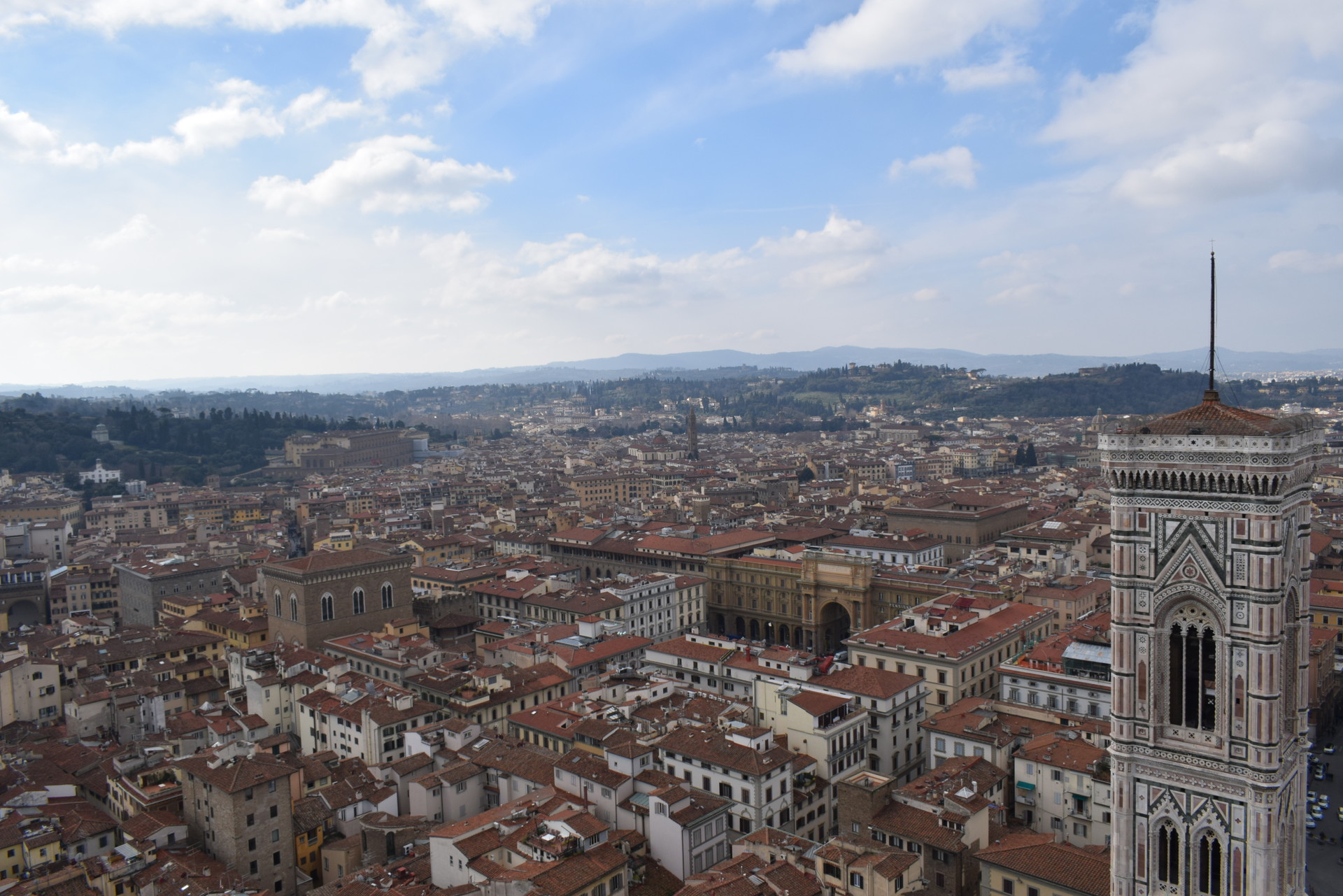
After we were done with admiring the beautiful paintings we went out on the terraces of the dome where we could enjoy one of the most beautiful views of Florence. From the Dome of Brunelleschi, we could oversee the Giotto's Bell Tower, the Basilica of Santa Croce in Florence and the city of Florence along with its part on the other side of the river Arno.
The Baptistery of Saint John
After our amazing climb up the Brunelleschi's Dome, we continued to the Baptistery of Saint John, which was in front of the Cathedral of Santa Maria del Fiore. The baptistery has an octagonal shape and it is covered in white and dark green marble pieces, which only adds to its beautiful exterior. According to the legend, the baptistery was a pagan temple once and then after Christian religion was spread around the Roman Empire it was turned into a church.
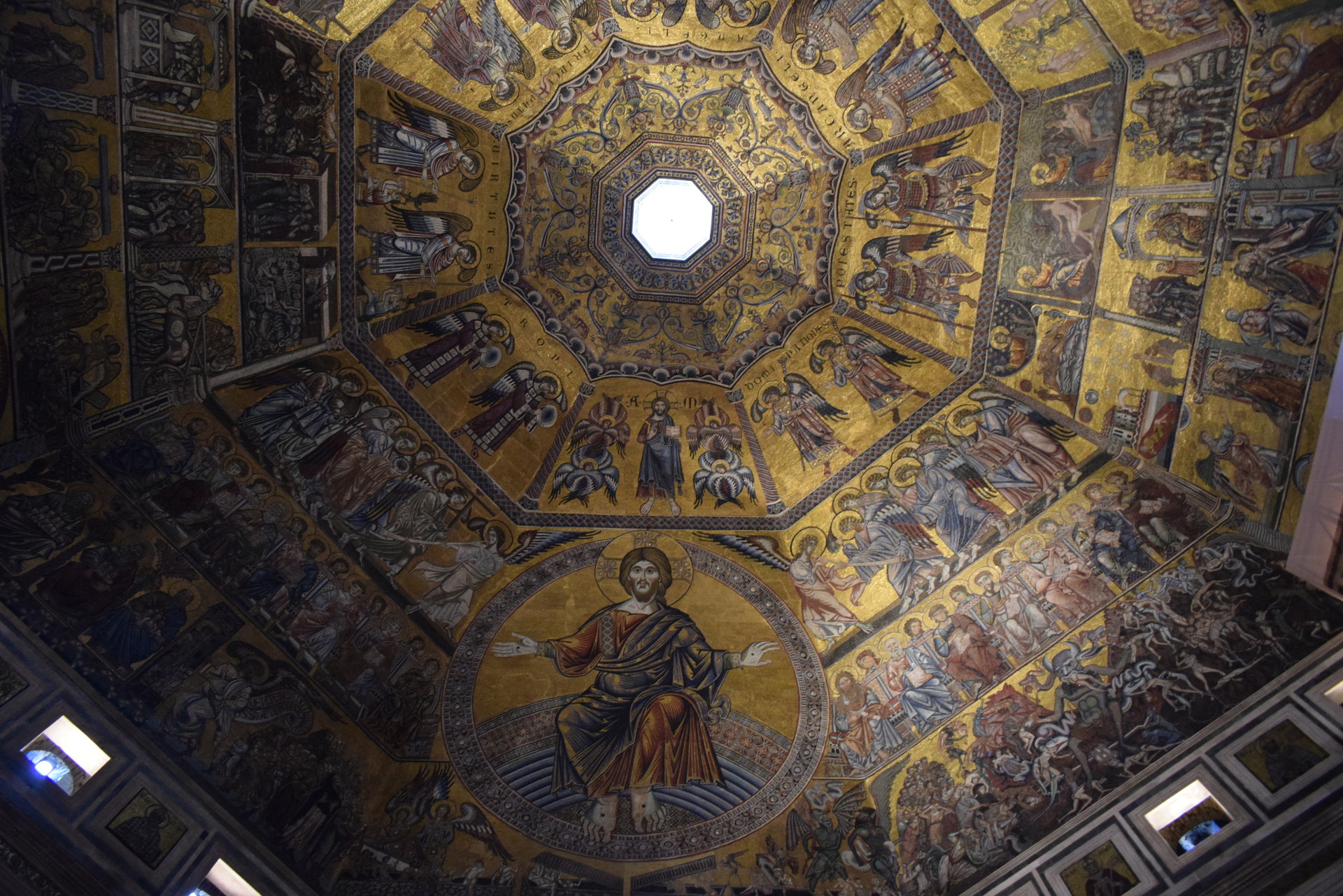
Inside of the baptistery is a quite small altar decorated with dark green and white marble and golden frescoes. The inner part of the dome is entirely covered with golden frescoes depicting the Last Judgement and the hierarchy of angels. In addition to that, below them, there is an astonishing mosaic ceiling that connects the dome with the columns of the baptistery that have golden heads. The floor of the baptistery is again made with geometrical mosaics in white and dark green marble pieces. In the baptistery, there are also a couple of Roman statues dating back to Roman times, another smaller altar, tombs and lots of pillars that were probably part of the pagan temple in the past.
The more interesting parts of the baptistery are its doors – the South doors designed by Pisano, the North doors and the East doors or as they are more famous the Gates to Paradise designed by Ghiberti. The South doors are made out of bronze and have 28 panels that are showing the life of Saint John the Baptist. The North doors again have 28 panels that are made out of bronze and in some parts gold. They are depicting scenes from the New Testament like the baptism of Christ, the Last Supper and the capturing of Christ.
Finally, the Gates to Paradise have 10 panels and were made out of bronze and covered in gold that were displaying scenes with Adam and Eve, Cain and Abel, Joseph, David, Noah and Solomon. However, the doors that are now part of the church are the copies of the originals, which are put on display in the Museum of the Opera of Saint Maria of Fiore.
Museum of the Opera of Saint Maria of Fiore
When we finished our exploration in the baptistery of Saint John we continued to the Museum of the Opera of Saint Maria of Fiore where all the original statues, doors and artifacts were gathered for better preservation.
On the first floor of the museum, there were one of the most interesting statues that were removed from the cathedrals. One of the most interesting rooms in the museum is the Salone del Paradiso where most of the statues are displayed as well as the original doors of the baptistery and the Galleria delle sculture, where I saw some of the finest sculptures ever.
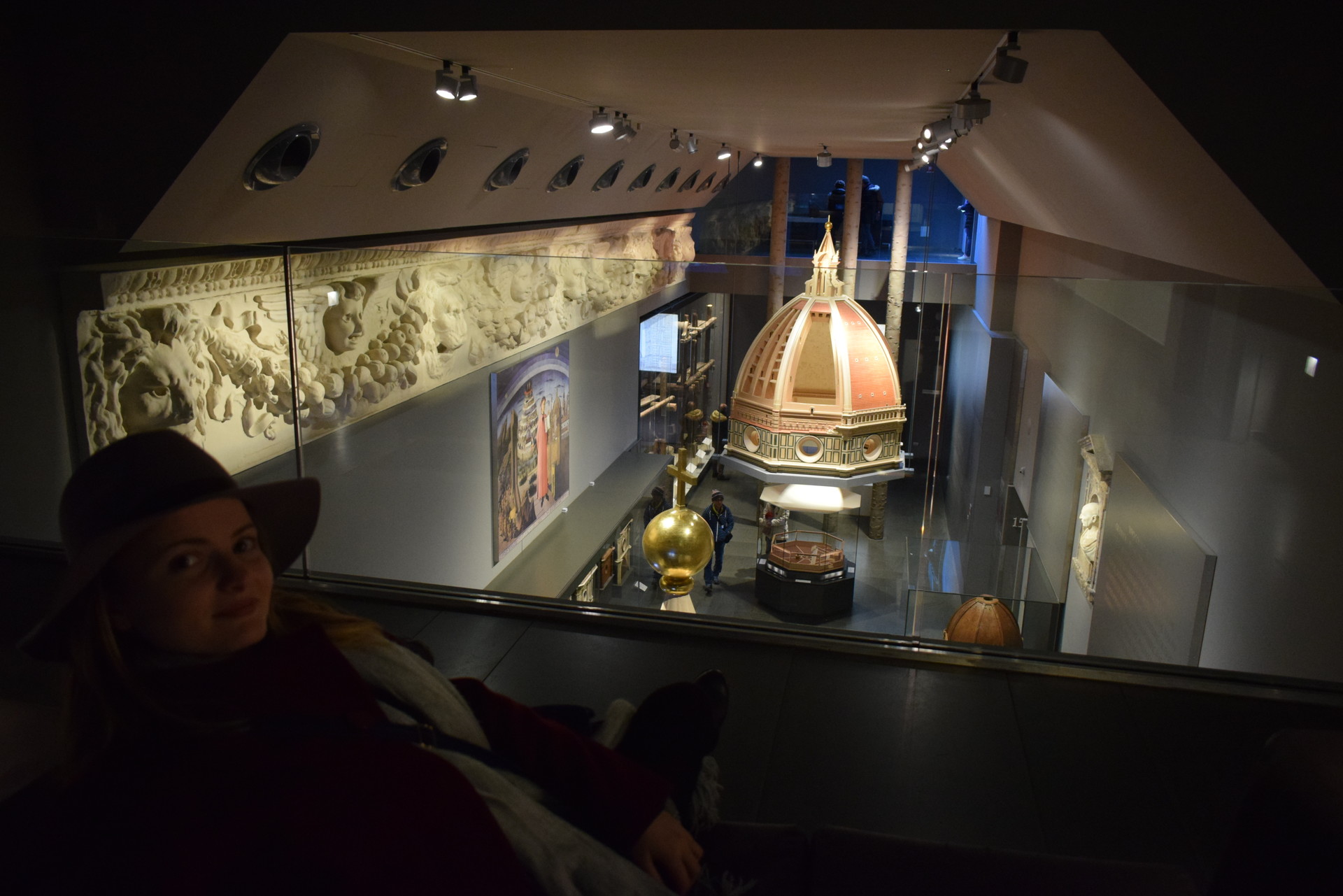
On the second floor, there are many artworks that were taken from the Bell tower in the Galleria del Campanile. Furthermore, in Sala delle Cantorie I found the choirs of the Duomo that were brought here to be preserved better for the future generations. Finally, on the last floor can be found the models of most of the buildings in Florence. In addition to that, the last floor leads to a terrace from which you can see the Brunelleschi's Dome standing very close to the museum.
Giotto's Bell Tower
Finally, we went to the Bell Tower of Florence, so we can enjoy the sunset over the city. The Bell Tower was designed around the fourteenth century by Giotto and built years later. It is considered to be one of the most beautiful towers in Italy and as per many historians, it had the only purpose to complement the Cathedral of Florence. It is almost ninety meters tall and is decorated in white, red and green marble pieces to complement the Cathedral of Florence. Over the tower, there are many hexagonal panels that are depicting the Creation of Adam and Eve and main labour works done by our accentors.
I have to say that climbing up to the top of the Bell Tower was not easy, but quite tiring, especially after a day of exploring the beautiful center of Florence. While going up we were taking breaks on the floors that had huge open windows overlooking the Cathedral of Florence and Brunelleschi's Dome. Finally, we reached the top of Giotto's Bell Tower from where we could enjoy the mesmerizing sunset with pink skies and admire the beauty of Florence. It was definitely the best way to finish the day.
Third day in Florence
On the third day, we explored mostly the other part of Florence after crossing the river Arno. There most of the landmarks were associated with the newer buildings that supported the Medici family and helped it thrive.
The Uffizi Gallery
We started our last day in Florence by stopping by to the magnificent Uffizi Gallery that holds one of the finest art collections of one of the most talented artists. While in the Uffizi Gallery we were able to buy a combined ticket for the Uffizi Gallery, Pitti Palace and the Boboli gardens, which cost us 18 euros each. Thus, after that, we started ours around two hours stroll around one of the most beautiful and mesmerizing galleries. The Uffizi Gallery took my breath away with its beautiful ceilings that were hand-painted, the floor that was just shinning and the way every single room full of masterpieces was arranged.

Some of the most famous paintings in the world were kept at Uffizi Gallery and one of them was the “Birth of Venus” by Botticelli. The painting represents the birth of the goddess of love and beauty, Venus, that emerges from the sea on the island of Cyprus. The goddess can be seen standing on a single shell with flower blowers and the Hora of spring. The painting is simply astonishing and captivating, so I spent some time there staring at it. Incredible!
Another incredible painting by Botticelli that caught my attention was “Spring”. This masterpiece took my breath away with its realness, tension and action gathered into one single painting. The painting shows the goddess of beauty and love, Venus. Then, it shows Flora, the spring goddess surrounded by lots of Graces and on the left is Mercury. The meaning behind this picture is to celebrate love, life and prosperity and belonged to the Medici family for a very long time.
Going further into the rooms I found the "Adoration of the Magi San Donato in Scopeto" by Leonardo da Vinci. This is one of the unfinished masterpieces of Leonardo da Vinci, which shows the Virgin and the child in the center of the painting. Behind and around them there are lots of people offering them gifts, as a way to show their respect. In the background, there are lots of destroyed buildings, which only adds to the tension of the painting. The painting got my attention, as it had a couple of scenes in every part of the picture and if you manage to observe every face on it you will realize the different meanings of every little detail added on it. Absolutely incredible!
The Uffizi Gallery was full of sculptures from ancient and medieval times. Among them, there were the sculptures of Eros, Cupid, Ariadne, Hercules, Venus and even a copy of the sculpture of the Porcellino was there.
Ponte Vecchio
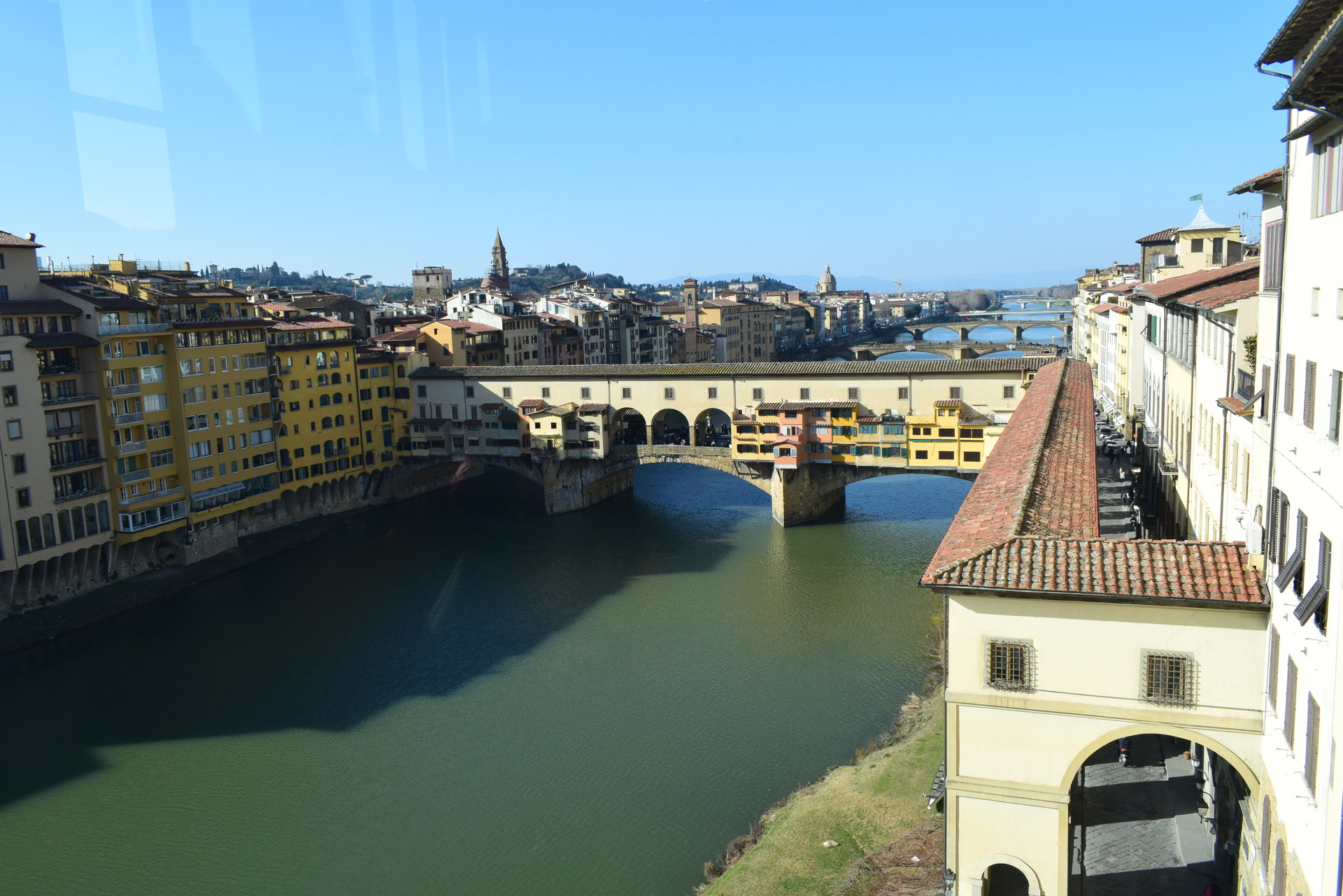
After our well-spent time in Uffizi Gallery, we went to the Ponte Vecchio, which is the oldest bridge in Florence and was built in ancient Roman times. It is also one of the most beautiful and romantic bridges in the city too. The interesting thing about the bridge is that it has a couple of floors and is painted in bright sunny colours, so it creates a very warm and romantic feeling when overseen from afar. When I went to cross the bridge there were many shops in which people were selling golden and silver pieces of jewelry and other precious goods. After we crossed the bridge we continued on the road and in no time we reached Pitti Palace.
Pitti Palace
The Pitti Palace was built around the fifteenth century for a wealthy Florentine banker Luca Pitti. However, later it was bought by the Medici family and was used by them as their residence, which held lots of their paintings, jewellery, plates, and other luxurious belongings.
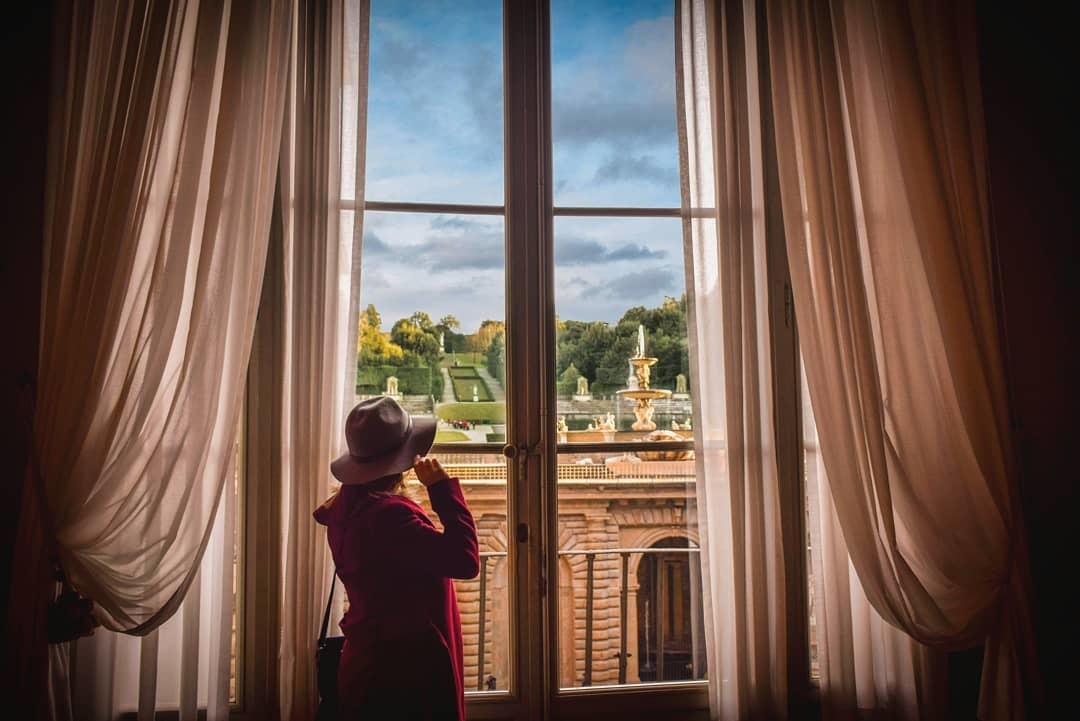
One of the most prominent parts of the palace is the Palatine Gallery, which holds one of the finest collections of paintings by Raphael, Titian, and Rubens. Raphael painted lots of artwork for the Medici family and one of them is Ezekiel’s Vision, which shows God in the middle surrounded by two angels and a couple of animals that are the symbols of the crusaders. Another masterpiece by Raphael is the Madonna del Granduca, which represents the Virgin Mary looking melancholically with the child in her arms.
Titian also painted lots of masterpieces for the royal family and one of them was The Concert that got my attention. It shows three men that were gathered to play music and at first, it seems very simple, but the details of the painting are simply mesmerizing. It almost seems like the people painted would come alive, it is that incredible.
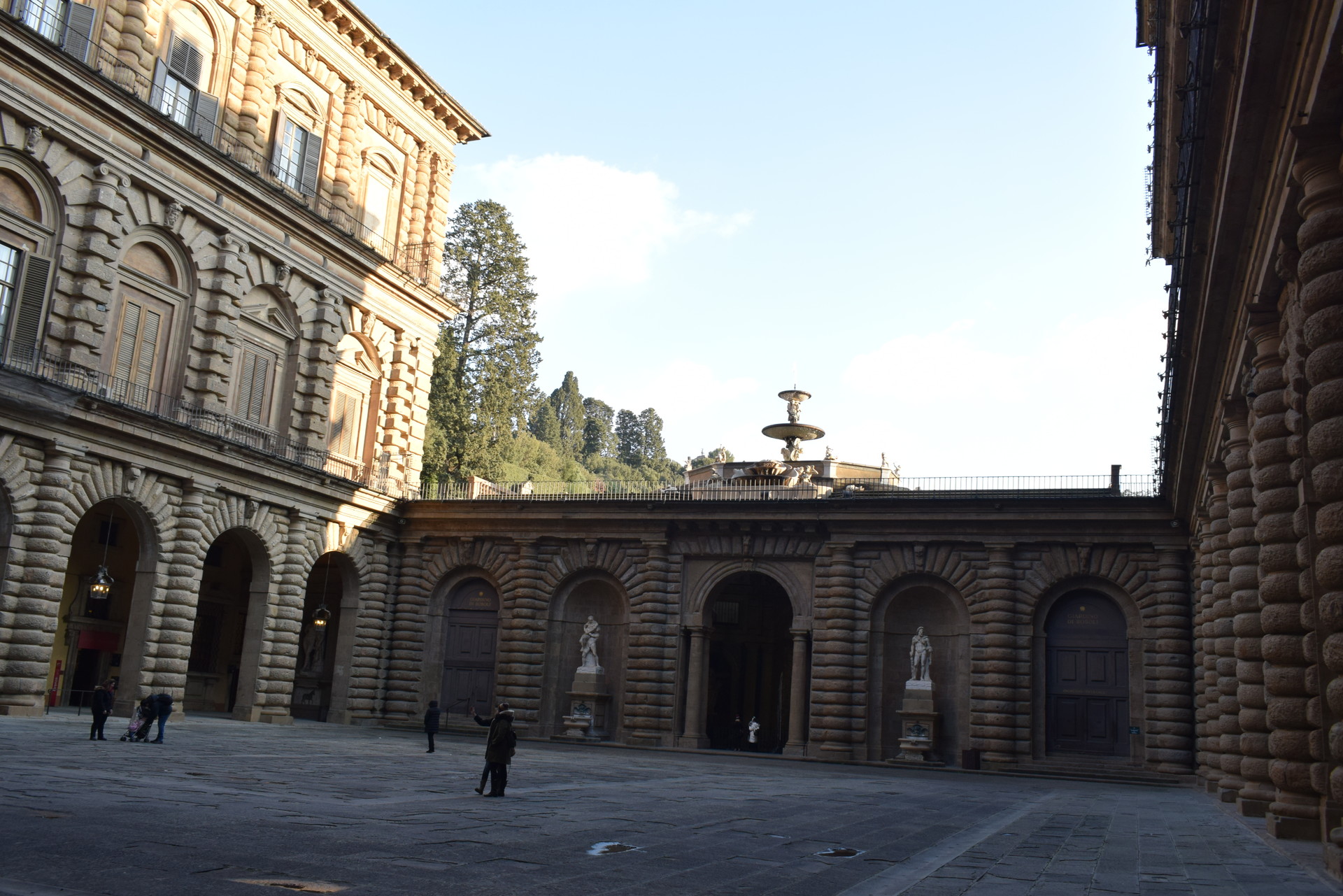
Around the palace, there were also many rooms showing the clothing of the royal families, their luxurious cutlery and also rooms that were kept exactly as the way they were. Most of the royal apartments were arranged in one colour, which means that one single room would have everything in green, blue, red or purple colour. The rooms were quite lavishly furnished and stuffed with lots of belongings of the royals.
The Boboli Gardens
Just behind the Pitti Palace are the Boboli Gardens that are one of the biggest gardens in Italy. The gardens are also holding one of the finest sculptures and buildings in them. Closest to the Pitti Palace is the Boboli Amphitheatre, which was mainly built for plays and performances, but later was used to keep the greenery of the gardens. However, later, during the Lorraine period, an obelisk was added in the middle of it, as well as the granite basin. These additions created a quite unusual look at the beginning of the gardens, but they were added mainly to show the wealth of the prominent family.
Going up the stairs is the Fountain of Neptune that is usually crowded with the birds that are inhabiting the Boboli gardens. The fountain is again representing the god of seas, Neptune standing in the middle of the basin surrounded by sea creatures. A bit to the left is the Kaffeehaus, which was built as a house for a wealthy duke from Lorraine. It is a very nice looking house overlooking the city of Florence with nice rose gardens on its front. Then, a bit straight was the Palazzina e Bastione del Cavaliere, which was another house with a very nice rose garden arranged in a very nice way overlooking the beautiful Tuscan hills. In the house there were fine collections of porcelain cutlery gathered for many centuries from the royal families of Florence, thus this is a must-see. There you will see one of the most beautiful plates, forks, spoons and other appliances used by the wealthy Florentine people.
Then, the Buontalenti Grotto caught my attention as it looked like an out of this world cave with lots of stalagmites and stalactites in different and unusual shapes. However, the Buontalenti Grotto first was the used as the water source of the Boboli garden, but later it was transformed into a cave by the request of Duke Francesco I. While I was there I went closer to take a look on the inside of the grotto and it was absolutely gorgeous. Inside there were lots of statues of people, animals, and trees made out of sponge-like rocks that were attached to fading paintings and were creating a rather tense scene. In the middle of the cave, there was a statue of Venus, which was put there, as it was considered the favourite goddess of the Medici family.
Going down the gardens we saw the Giardino Della Botanica superior, which was another garden that had a very beautiful view over the city of Florence. In the middle of the garden, there was a very artistic sculpture of a big rustic head, which was only adding to the Gothic and Romantic style of the gardens.
Finally, we saw the Fontana dell' Oceano, which is the largest fountain in the Boboli gardens. In the middle, we saw Neptune standing and surrounded by other minor gods pouring water in the basin. Then, we continued straight to the exit of the Boboli Gardens.
The Porta Romana in Florence
The Porta Romana is an ancient gate that belonged to the walls of Florence and was built around the fourteenth century. The gate is quite well-preserved and as far as I know and saw it still has the original iron doors and also the Medici’s sign on it. An interesting fact is that from the gate there are a couple of main streets used by the ancients to navigate around Italy and one of the most important ones was the road leading to Rome. Furthermore, at the roundabout the is a marble statue of two female figures and each of them points to a different direction. One of them is pointing to the road that leads to Rome and the other one to Via Romana, which leads to the city of Florence.
Photo gallery
Content available in other languages
- Español: Tres días en Florencia
Want to have your own Erasmus blog?
If you are experiencing living abroad, you're an avid traveller or want to promote the city where you live... create your own blog and share your adventures!
I want to create my Erasmus blog! →

























Comments (0 comments)